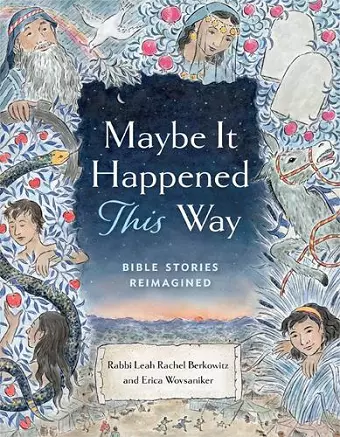Maybe It Happened This Way: Torah Stories Reimagined
Leah Berkowitz author Erica Wovsaniker author Katherine Messenger illustrator
Format:Hardback
Publisher:Behrman House Inc.,U.S.
Published:20th Oct '22
Should be back in stock very soon

This spirited collection will make the Jewish people’s beginnings tangible to today’s readers. --KIRKUS REVIEWS
Take a fresh look at the Bible stories you think you know, retold using the Jewish concept of midrash.Adam and Eve, Abraham and Sarah, Moses. We think we know their stories, but the Bible tells us only part of it. What if we could see the full picture?
Maybe we’d discover that…
…Adam and Eve were challenging the rules, growing up.
…Noah felt fearful and angry, desperate for any kind of hope.
…Abraham and Sarah gleefully, recklessly smashed idols in his father’s workshop, and were stunned by a revelation that would change their world.
…Moses could not imagine that the Israelites would want to follow him, and felt dread at being asked to lead.
Maybe these iconic figures of the Bible were people just like us, filled with fear and joy, jealousy and passion, mischief and love.
Maybe it happened this way.
This is a modern take on Bible stories, with relatable characters; not earnest and reverent, but not transgressive either. It explores timeless themes of interest to kids, including fairness, sibling rivalry, perseverance, forgiveness, courage. Maybe It Happened This Way also covers many lesser-known narratives and lifts up the stories of women in the Bible as well.
Includes an introduction explaining of the Jewish concept of midrash--stories created to add new layers to our understanding of the Bible; a discussion guide with questions; an index of values; and a guide to sources for each Bible story.
Stories from the Torah, the Old Testament’s first five books, are enlivened.
A Reform rabbi and a Jewish educator use the original text, midrashim (stories that "search or explore" the original Bible), and their own creativity to reinterpret the well-known tales about Adam and Eve, Noah, Abraham, Sarah, Moses, Aaron, Miriam, and others. Sometimes they invent characters, and in the last story, they leap into the future, juxtaposing Moses writing the Torah with God telling him about the questions future people will have, even mentioning the smartphone, to show the continuing importance of Jewish learning. Though the events are familiar—the Great Flood, the departure from Egypt and the long desert sojourn—the storytelling is engaging. The biblical figures have strong personalities, and the authors make playful asides, such as a remark from God to Moses when the great leader is worried about his brother’s feelings: "When was the last time you saw Aaron happy?" Although traditionalists may not be comfortable with these adaptations, the stories make real the joy and suffering of the Jewish people during their early days. With particularly rich backmatter (including excellent discussion questions), the book will be useful for some Jewish education programs, but individual readers will also enjoy this less formal approach to the stories that have been taught in religious schools and homes and mentioned in secular literature for centuries. Simple black-and-white vignettes accompany chapter headings and are interspersed throughout.
This spirited collection will make the Jewish people’s beginnings tangible to today’s readers. (descriptions of Jewish values and the stories that relate to each value, index of values and sources) (Religious anthology. 10-13) ---KIRKUS REVIEWS
Children are often taught stories from the Bible as midrashim. These tales can be presented in an engaging yet simple manner, allowing their built-in lessons to shine through. Occasionally thoughts, comments, and events are added in an attempt to bring the stories to life, with the result that they are often long-remembered. But there can be a drawback to this method of learning. Children don’t always distinguish between the original stories told in the Torah and these more colorful, memorable versions. This book and its unusual approach eliminates that problem. It explains the concept and uses of midrash while relating the stories in a relatable and interesting way.The authors share twenty tales, each clearly and memorably told. In introductory sections, the authors explain midrash in a way that children can understand, allowing them easy access to the deeper, richer versions of the stories to come and eliminating any possible confusion. The story of Adam and Eve, their encounter with the Serpent, and their expulsion from the Garden of Eden receives a poignant rendering; Noah and his relationship with his grandson as they look toward the future feels endearingly optimistic; and Abraham’s smashing of his father’s idols is nuanced and complex. Rebecca, Rachel, Leah, Joseph, Benjamin, Moses, Aaron, Miriam, and others make appearances in ways that both educate and entertain. Not only that, the text appears alongside black and white line drawings that enhance understanding and clarity.With this book, children learn that there is more than one way to tell a good story and have its lessons stick. They begin to understand the usefulness of learning about the Bible through midrashim in addition to the traditional approach of reading directly from its pages.A useful discussion guide concludes the text, homing in on Jewish values and questions for further thought and discussion. There is also an index that ties each story back to its original Torah source. ---MICHAL MALEN, THE JEWISH BOOK COUNCILISBN: 9781681155869
Dimensions: unknown
Weight: unknown
216 pages